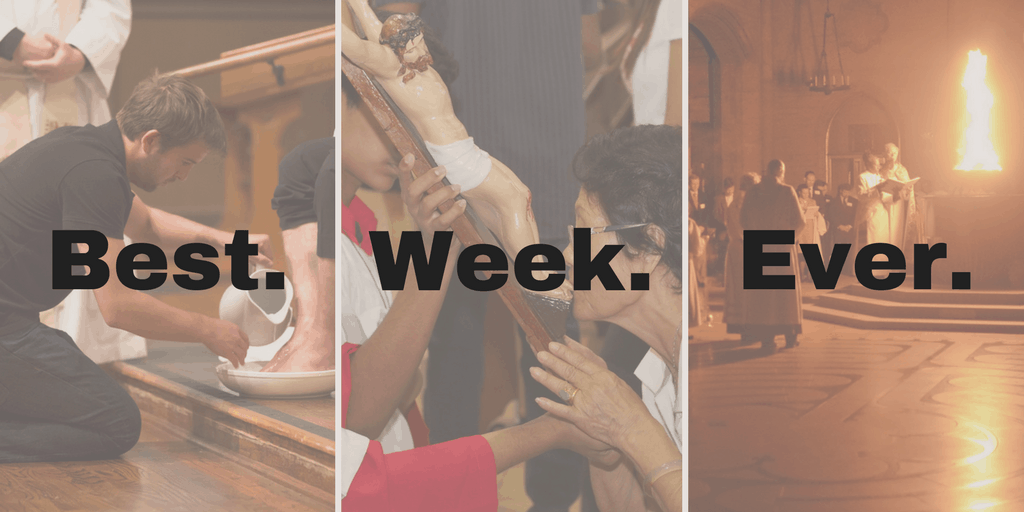The Oscars are long gone. March Madness is over. The Masters just wrapped up. Summer blockbusters are still weeks away. House of Cards? Not out until May. Game of Thrones? July.
Do not fret! We have just begun the best (liturgical) week of the year!
That’s right- with Palm Sunday yesterday, Holy Week has started. Despite what contemporary culture wants us to think, Easter is more than pastel colors, dyed eggs and bunny rabbits.
A confession: I am no liturgical guru. But even as a Catholic in the pew, I just can’t get enough of Holy Week. It is the richest and most intricate liturgical season of the year. Don’t let the best of it pass you buy as you wait for Easter Sunday. The Triduum, starting on Holy Thursday, kicks off three amazing days of liturgy.
Here’s what you don’t want to miss:
Holy Thursday: The Last Supper Re-Lived and Feet Washing
Holy Thursday specifically commemorates the Last Supper, when Jesus celebrated dinner with his disciples before his arrest, crucifixion and death. Of course, we celebrate this event at every Mass, but Holy Thursday is special. Don’t believe me?
Take, for example, the foot washing. During the Last Supper in the Gospel of John, instead of “breaking of the bread” as he does in the other three Gospels, Jesus kneels before his disciples and washes their feet. It is a moving image that carries a beautiful message of humility.
Think about the dusty feet of sandal-clad Israelites. Jesus tenderly washes them clean in a large basin of water, moving from one to the next. “I have given you a model to follow, so that as I have done for you, you should also do,” Jesus tells the disciples.
So…when exactly do we follow this model of Jesus? Holy Thursday of course! It is the one liturgy of the year that includes the “washing of the feet” rite. It is a favorite of Pope Francis, as we can recall his moving acts of washing the feet of inmates and migrants of various faiths. In fact, under Pope Francis’s instructions, the rite was modified last year so that more people could partake in it. Pretty special, right?
Good Friday: Darkened Churches, All-Night Vigils, and Kissing the Cross
Good Friday commemorates the crucifixion and death of Jesus: a solemn day to be certain. And sure enough, there are some unique liturgical events to capture this day.
You don’t have to wait long. When the Holy Thursday Mass ends, the great drama of Good Friday begins. The altar is stripped, and the Eucharist in the tabernacle is taken away. The transformation is stark: the main church sanctuary is left darkened and bare. The Eucharist is brought to an “altar of repose”: basically a temporary or separated altar that is solemnly decorated in another part of the church or the parish property and left accessible throughout the night for adoration.
A great way to check out the altars of repose is partaking in the tradition of the Seven Churches Visitation. After the Holy Thursday Mass, groups make a pilgrimage to seven different altars of repose in neighboring churches. You can see if your local parish organizes such a group, or just get some friends together and google search “Catholic churches” near you. It is impressive to see the different ways the altars are set up, and to join in prayer with people from various parish communities. Plus it has the feel of a holy scavenger hunt.
During the daytime, don’t go looking for a Mass: Good Friday is the only day in the whole year when NO Mass is celebrated.1 Instead, the day’s liturgy takes on a character all its own. It starts similar enough with the readings, although during the Gospel, the full Passion account is read, just like Palm Sunday. Don’t get drowsy during the lengthy retelling of the Passion: in most cases, even the congregation has parts to read aloud. It is interactive!
Without the whole Eucharistic prayer of a typical Mass, the second half of the liturgy puts the focus on the cross. Literally. A big wooden cross is stationed in front of the altar for the Adoration of the Cross. Everyone has the opportunity to approach the cross and make a sign of veneration, such as a light kiss or a gentle touch. Between the solemn music and the slow procession of people, it is a captivating experience.
Although there is no consecration during the service, Communion from the “altars of repose” is distributed to the congregation. So yeah, it is kind of like a Mass, but definitely not a Mass, with the adoration of the cross. How is that for unique??
Holy Saturday: [Time Out]
Hold onto your seats because the best is yet to come! (Hint: Jesus’ Resurrection) But you’ll have to wait. Technically, Holy Saturday is the only day without its own liturgy.2 Nothing to do all day? Just think about Jesus’ disciples. This day, sometimes called the “Long Sabbath,” was a full day in which Jesus’ body was in the tomb and the disciples were hanging in uncertainty. Try to place yourself in their shoes for this day. The man they had been following, who they believed was the Messiah, was brutally tortured and hung to die. Most of the Apostles betrayed or abandoned him. Now he’s buried. So, now what?
Easter Vigil: Blazing Fires, Salvation History Retold, and New Catholics (Alleluia!)
Gratefully, we know how the story ends. And the beauty of the Easter Triduum strikes the highest note with the Easter Vigil that starts after sundown on Holy Saturday. This is the Mass to end all Masses. The U.S. Catholic Conference of Bishop’s website literally describes it as “the mother of all vigils” (is that a hashtag?) and the “greatest and most noble of all solemnities.” Buckle up, it is quite a ride!
The Vigil starts with the “Service of Light,”3 which (conditions permitting) takes place around a blazing fire outside of a darkened church after nightfall. The Paschal candle makes its debut: this giant candle is in the church sanctuary throughout the year, but it gets replaced every year during the Easter Vigil.
The Paschal candle gets lit from the roaring bonfire and everyone processes into the Church with it. From that one candle, the flame is passed around until everyone in the congregation has a lit candle. The darkened church is aglow with candlelight, all originating from the one Paschal candle. This gives me chills every time.
One thing to know about the Easter Vigil: it is not quick. Rich in meaning and packed with different rituals, this is not one of those Masses that clocks in at one hour on the dot. Case in point is the readings. There are usually seven from the Old Testament, two from the New Testament, and a psalm in between each one. Yes, nine readings altogether, plus the psalms. But in all those readings, you get the whole picture of salvation history. The readings include the creation story of Genesis (“In the beginning…”), stories of Abraham and Moses, readings from the prophets (“All you who are thirsty, come to the water!”), and of course, the Resurrection account. The classics.
Along with all the readings, two celebratory parts of the Mass that get omitted during Lent make a triumphant return on the Easter Vigil. The Gloria and the Alleluia. Sing them loud and proud!
After the Liturgy of the Word, it is time for the rituals of initiation, when new Christians are welcomed into the Church through baptism and confirmation. For those catechumens and candidates who have been preparing to enter the Church, this is the big day. The entire ritual is filled with meaningful moments. For example, the new Paschal candle is plunged into the baptismal font to bless the water; the baptismal candles gets lit from that same Paschal candle; the catechumens dress in white garments signifying the entrance into new life with Christ through baptism. For both baptism and confirmation, the oils that were just blessed at the Chrism Mass4 from Holy Thursday are first used.
The ordinary minister for Confirmation is a bishop, as anyone who was confirmed through their Catholic grade school can attest. But the Easter Vigil is the most common instance when the circumstances permit a priest to perform a confirmation. Are you catching the theme: this is not a normal liturgy!
Once we finally arrive at the Liturgy of the Eucharist (usually a couple hours after we started this whole adventure), the Mass proceeds as expected. But remember, this is the first celebration of the Liturgy of the Eucharist since Holy Thursday, back when we were washing feet. Whew, what a journey!
Easter Sunday: Pastel Colors, Dyed Eggs, Bunny Rabbits…oh, and Christ is Risen!
If you have made it through all of that, sleep in on Sunday.5 But if you couldn’t make the Vigil, Easter Sunday is a beautiful, joyful Mass. The Gloria and the Alleluia are back, and there is a beautiful Paschal “Sequence” (a special chant or hymn) before the Gospel. The readings talk of the Resurrection, and we celebrate the start of the Easter season.
Yes, the Easter season- the Triduum and Easter Sunday don’t just bring Lent to an end. They start the 50-day long Easter season with the octave of Easter. It is a celebration so big, it can’t be contained in just one day!
And there is much to celebrate during those 50 days. Summer blockbusters are coming, the NBA and NHL Playoffs are starting…and more importantly, Christ has risen!
***
Image complied from FlickrCC users Bruce Alexander, John Ragai, and Daniel Parks.
- According to Church practice, there are no Masses on Good Friday AND Holy Saturday. The Easter Vigil, which takes place after sunset on Holy Saturday, is considered the start of Easter Sunday. But it takes place before midnight, so my point is that it is still technically on Saturday. ↩
- See previous footnote. At least Good Friday has a liturgy even though it’s not a Mass. Holy Saturday has no liturgy at all. The Easter Vigil technically takes place on Saturday night, but it is considered part of Easter Sunday. ↩
- “Lucernarium” in fancy Latin. ↩
- If the feet washing isn’t enough for you on Holy Thursday, you can always go to the Chrism Mass at your local cathedral. This is the Mass to bless literally all of the holy oils that are used for baptism, confirmation, ordination, and blessing the sick during the whole year. Another unique liturgical tradition of Holy Week! ↩
- The Easter Vigil fulfills your Sunday obligation. ↩


